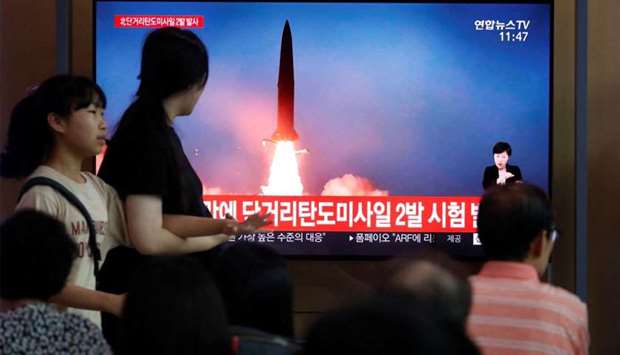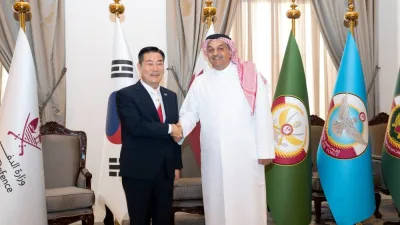* N.Korea fires projectiles from its east coast
* S.Korea says projectiles were short-range ballistic missiles
* Firing comes before US-S.Korean military exercises
* Launches follow talks between US, N.Korean leaders
* Washington still sees hope for diplomatic progress
North Korea fired two short-range ballistic missiles early on Wednesday, the South Korean military said, only days after it launched two similar missiles intended to pressure South Korea and the United States to stop upcoming military drills.
The launch follows launches on July 25, North Korea' first missile tests since leader Kim Jong Un and US President Donald Trump met on June 30 and agreed to revive stalled denuclearisation talks.
The series of missile tests raises the stakes for US and South Korean diplomats criss-crossing the region this week in the hope of restarting talks aimed at persuading Pyongyang to give up its nuclear weapons and ballistic missile programmes.
‘North Korea's actions do not help ease military tensions, nor do they help keep the momentum for talks that are under way,’ South Korean Foreign Minister Kang Kyung-wha told reporters in Seoul before leaving for a Southeast Asian security forum in Bangkok.
Kang urged North Korea to halt the missile launches.
US Secretary of State Mike Pompeo and the top US North Korea negotiator were also headed to the Association of Southeast Asian Nations (ASEAN) Regional Forum in the Thai capital, where Pompeo said he was holding out hope that US officials could meet North Korean counterparts.
Trump and Pompeo both played down last week's launches and Pompeo has continued to express hope for a diplomatic way forward with North Korea.
The latest launch comes ahead of newly appointed US Secretary of Defense Mark Esper's first official visit to Seoul, which the Pentagon said on Tuesday was scheduled as part of a tour through Asia in August.
US military forces in South Korea were aware of Wednesday's launch, a spokesman said.
NEW MISSILES
Wednesday's launches were from the Wonsan area on North Korea's east coast, the same area from where missiles were fired last week, South Korea's Joint Chiefs of Staff (JCS) said in a statement. It said it was monitoring in case of more launches.
The JCS said later the North had fired ballistic missiles that flew about 250 km (155 miles) and that they appeared to be similar to those launched last week.
The missiles, dubbed the KN-23, are designed to evade missile defence systems by being easier to hide, launch, and manoeuvre in flight, experts said.
Kim described the two KN-23s launched last week as having a ‘low-altitude gliding and leaping flight’ pattern that would make them hard to intercept.
Analysts said the range and altitude of Wednesday's flights could indicate a demonstration or test of those capabilities.
South Korean defence minister Jeong Kyeong-doo told a defence forum in Seoul that stopping a missile like the KN-23 would be difficult, although South Korea's missile defence systems would be able to detect and intercept them.
South Korea's defence ministry also told lawmakers in Seoul it had concluded that a new submarine the North showcased last week was capable of carrying up to three ballistic missiles.
Japanese Prime Minister Shinzo Abe said there was no impact from Wednesday's launch on Japan's security.
‘We will continue to closely cooperate with the United States and others,’ Abe told reporters.
Chief Cabinet Secretary Yoshihide Suga said Japan would still seek a summit with North Korea, without conditions, despite the latest launch.
'BARGAINING CHIP'
Trump and Kim met on June 30 in the Demilitarized Zone (DMZ) between the two Koreas but Pyongyang has since accused Washington of breaking a promise by planning to hold joint military exercises with South Korea next month and warned the drills could derail talks.
North Korea has also warned of a possible end to its freeze on nuclear and long-range missile tests that has been in place since 2017, which Trump has repeatedly upheld as evidence of the success of his engagement with Kim.
A top South Korean official said last month the drills would mainly involve computer simulations.
Henri Feron, a senior fellow at the Washington-based Center for International Policy, said the United States and South Korea may need to consider a temporary suspension of the drills, or propose other measures to reduce tensions.
‘I do think there is a high risk that talks will end altogether if Washington and Seoul continue to ignore North Korea's concern with the exercises,’ he said.
A summit between Trump and Kim in Vietnam in February collapsed after they failed to reconcile differences between Washington's demands for Pyongyang's complete denuclearisation and North Korean demands for sanctions relief.
Trump says he has a good relationship with Kim and Pompeo said on Monday he hoped working-level talks could occur soon.
Pompeo told reporters travelling with him to Asia on Tuesday he did not know when this would happen but hoped US Special Representative for North Korea Stephen Biegun and his new counterpart could meet soon.
North Korean Foreign Minister Ri Yong Ho cancelled a planned visit to the ASEAN forum in Bangkok but Pompeo said the Americans were still open to a meeting.
Harry Kazianis, of Washington's Center for the National Interest think tank, said the latest launches were a clear attempt by North Korea to put pressure on Washington.
Other analysts have said North Korea will be emboldened to press more aggressively for US concessions by Trump's apparent eagerness to hold up his engagement with Pyongyang as a foreign policy success ahead of his 2020 reelection bid.



